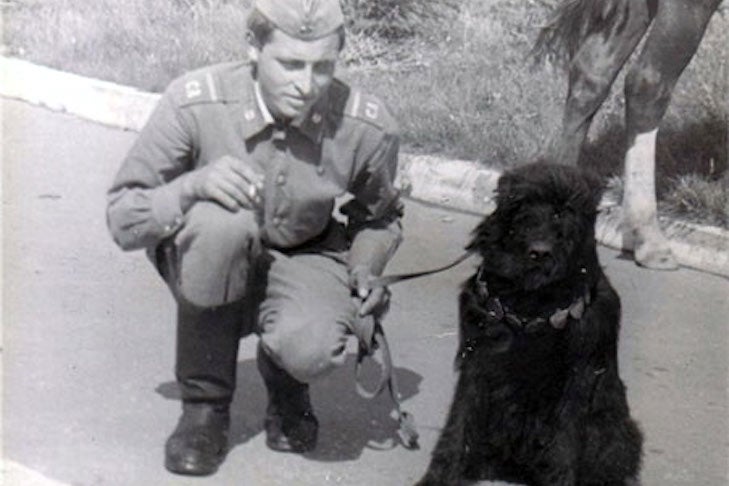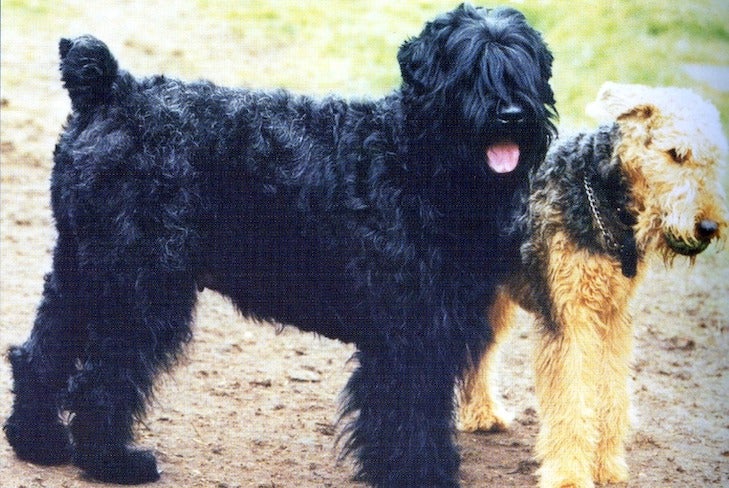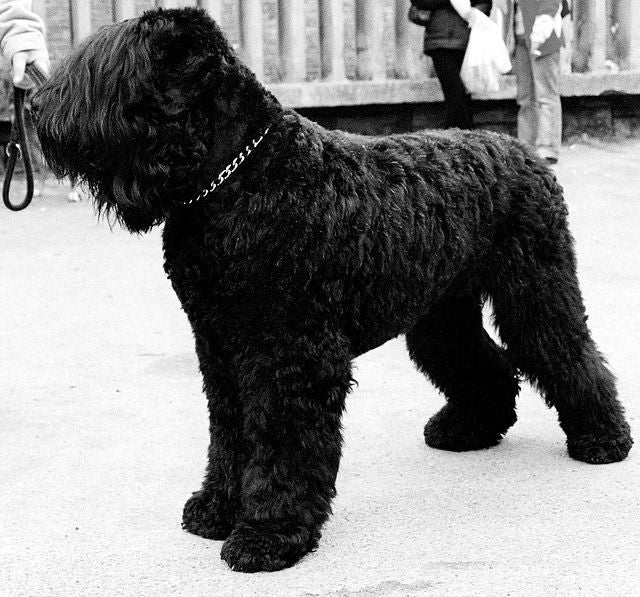
Necessity is the mother of invention, the saying goes. And no dog illustrates that better than the Black Russian Terrier.
This relatively new breed – barely two decades in the making – was developed after World War II, when Europe was divided into two geopolitical spheres: the Western bloc led by the United States and the Eastern bloc that coalesced around the republics of central and eastern Europe annexed by the Soviet Union.
The situations of those two world powers could not have been more different: The United States economy was buoyed by Americans’ pent-up desire to spend the cash they had stashed away during the war years, and that domestic boom was matched internationally by the Marshall Plan, which poured billions into rebuilding Western Europe. By contrast, the nascent Soviet Union found itself devastated both socially and economically as it struggled to rebuild its war-battered population and infrastructure.
The Soviet Military’s New, Go-To Military Dog
While the German Shepherd had become the go-to military dog by the early 20th Century, the postwar Russian government was looking for an even hardier, more cold-resistant breed to accompany its national-security forces. In sort of the canine version of rummaging around the fridge to see what you can whip into a casserole for dinner, the Soviet military decided to develop this new, uniquely Russian breed from the dogs on hand at the government’s Red Star kennel in Moscow.
In truth, the program to develop a uniquely Russian guard breed had been started at Red Star in the 1930s, but it was stymied by the lack of purebred stock after the Russian Revolution (which almost led to the extinction of a much more ancient homegrown breed, the Borzoi), followed by the deprivations of World War I. The aftermath of the second world war, and Russia’s control over East Germany, brought fresh stock from two important German breeds – the Rottweiler and Giant Schnauzer.

From the late 1940s well into the ’50s, the Russian military kennel methodically crossbred between some 17 breeds, which included Caucasian Ovcharkas and even Poodles. Eventually, the Red Star kennel came up with a dog whose very descriptive Anglicanized name is at least two-thirds accurate: The Black Russian Terrier is indeed black (any other color is a disqualification), and it is indeed Russian. But it is most definitely not a terrier.
The misnomer likely comes from the use of the Airedale Terrier, which, along with the aforementioned Rottweiler and Giant Schnauzer as well as the Newfoundland, was one of the four main breeds used to develop the breed. Surprisingly, Airedales have a relatively long history in Russia: These largest and most versatile of all the terriers proved to be hugely successful war dogs, and even before the Airedale’s impressive performance in the trenches during World War I, Russia had imported a number of them for use during the Russo-Japanese War in the early 1900s.
The Airedale’s versatility and relatively large size were important components for this emergent Russian breed, which needed to not only be resistant to the grueling winters but also adaptable to many different settings, from border crossings to prison camps.
Of course, the breed’s black coat – with a hard, dense outer coat that repels the elements to protect the softer, insulating undercoat beneath – was an important part of breed identity from the earliest years. But the Black Russian Terrier was bred first and foremost for working ability, with appearance a secondary consideration. The dogs needed to be intelligent, stable, and reliable, as well as courageous enough to address an adversary if the situation called for it.

The Black Pearl of Russia
By 1955, the Black Russian Terrier had been standardized enough to be unveiled to the public at a show in Moscow. Within several years, the Red Star kennel published the first breed standard. Slowly, the breed spread under military control across the vastness of the Soviet Union, from Ukraine to Siberia, and eventually was smuggled to Europe and beyond. Some 30 years later, in 1984, the Federation Cynologique Internationale (FCI) recognized the breed. By the following decade, “Blackies” had arrived in North America, though it was not until 2004 that the American Kennel Club formally recognized the breed.
To be sure, the Black Russian Terrier was not the only new breed to be developed in the Stalin-era Soviet Union. The Red Star kennel also developed the Moscow Watchdog, which resulted from crosses between St. Bernards and Caucasian Ovcharkas, and Ukraine was responsible for the East European Shepherd – a sort of supercharged German Shepherd Dog with heavy bone and snow-shoe-shaped feet. But the Black Russian is the only one of these 20th-Century creations to have reached international acceptance, with dedicated fanciers and breeders across the globe.
As it traveled far from the military kennel that brought it into being, the breed earned the moniker “the Black Pearl of Russia.” The metaphor is a rather apt one: Like that valuable gem, which is formed as a barrier against irritants or intruders in a mollusk’s shell, the Black Russian Terrier also evolved for reasons of defense and protection.
And since dog breeds, like pearls, very rarely occur naturally, without some degree of human intervention, the Black Russian Terrier is perhaps the most extreme example of a cultured purebred, developed and perfected in only a handful of decades.

